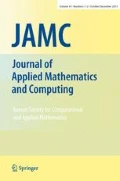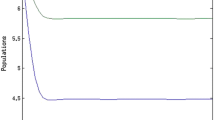Abstract
In this research, we discuss balancing two essential ecosystem services, known as resilience and yield, in a harvested two predators one prey system. We study how these two ecosystem services respond to different types of harvesting plans applied to the system. In individual harvesting, we observe that prey harvesting is suitable for generating more yield while either predator harvesting gives more resilience. Several patterns are possible based on the intensity of harvesting efforts applied to prey or the predator in simultaneous harvesting. This study shows that a balanced harvest between prey and predators may give more than the selective harvesting of any species yielding and stabilizing the ecosystem. Even if this fair strategy is not a cooperative situation for both resilience and yield, it may be the most favorable approach to scale those services. Finally, we may state that it would help us correlate the safest position (corresponds to the maximizing resilience yield) and the good views (which corresponds to the maximum sustainable return) to safeguard our ecosystems.








Similar content being viewed by others
References
Araki, K., Masaoka, T., Okamoto, H., Nagoya, H., Naramura, H., Muto, K., Oku, H., Aoki, J.Y., Suzuki, T.: Experimental hybridization and competition between Atlantic Salmon (Salmo salar) and native Salmonid Species in Japan. Bull. Jap. Fish. Res. Edu. Agen. 45, 75–87 (2017)
Birkhoff, G., Rota, G.C.: Ordinary differential equations. Ginn, Boston (1982)
Breed, G.A., Don Bowen, W., Leonard, M.L.: Behavioral signature of intraspecific competition and density dependence in colony-breeding marine predators. Ecol. Evol. 3(11), 3838–3854 (2013)
Britten, G.L., Dowd, M., Minto, C., Ferretti, F., Boero, F., Lotze, H.K.: Predator decline leads to decreased stability in a coastal fish community. Ecol. Lett. 17(12), 1518–1525 (2014)
Clark, C.: Mathematical bioeconomics. John Wiley and Sons Inc., New York (1990)
Clark, C.W.: The worldwide crisis in fisheries: economic models and human behavior. Cambridge University Press, Cambridge (2006)
Djilali, S., Bentout, S.: Spatiotemporal patterns in a diffusive predator-prey model with prey social behavior. Acta. Appl. Math. 169, 125–143 (2020)
Djilali, S.: Pattern formation of a diffusive predator-prey model with herd behavior and nonlocal prey competition. Math. Meth. Appl. Sci. 43, 2233–2250 (2020)
Dunn, R.P., Baskett, M.L., Hovel, K.A.: Interactive effects of predator and prey harvest on ecological resilience of rocky reefs. Ecol. Appl. 27(6), 1718–1730 (2017)
Estes, J.A., Terborgh, J., Brashares, J.S., Power, M.E., Berger, J., Bond, W.J., Carpenter, S.R., Essington, T.E., Holt, R.D., Jackson, J.B., et al.: Trophic downgrading of planet earth. Science 333(6040), 301–306 (2011)
Froese, R., Walters, C., Pauly, D., Winker, H., Weyl, O.L., Demirel, N., Tsikliras, A.C., Holt, S.J.: A critique of the balanced harvesting approach to fishing. ICES J. Mar. Sci. 73(6), 1640–1650 (2015)
Geček, S., Legović, T.: Impact of maximum sustainable yield on competitive community. J. Theor. Biol. 307, 96–103 (2012)
Ghosh, B., Kar, T.: Possible ecosystem impacts of applying maximum sustainable yield policy in food chain models. J. Theor. Biol. 329, 6–14 (2013)
Ghosh, B., Kar, T.: Sustainable use of prey species in a prey-predator system: jointly determined ecological thresholds and economic trade-offs. Ecol. Model. 272, 49–58 (2014)
Ghosh, B., Pal, D., Legović, T., Kar, T.: Harvesting induced stability and instability in a tri-trophic food chain. Math. Biosci. 304, 89–99 (2018)
Ghosh, B., Paul, P., Kar, T.: Extinction scenarios in exploited system: combined and selective harvesting approaches. Ecol. Complex. 19, 130–139 (2014)
Gunderson, L.H., Allen, C.R., Holling, C.S.: Foundations of ecological resilience. Island Press, Washington (2012)
Hill, S., Reid, K., Thorpe, S., Hinke, J., Watters, G.: A compilation of parameters for ecosystem dynamics models of the scotia sea-antarctic peninsula region. Ccamlr Sci. 14, 1–25 (2007)
Holling, C.S.: Resilience and stability of ecological systems. Ann. Rev. Ecol. Syst. 4(1), 1–23 (1973)
Kar, T., Ghosh, B.: Impacts of maximum sustainable yield policy to prey-predator systems. Ecol Modell. 250, 134–142 (2013)
Kar, T.K.: Management of a fishery based on continuous fishing effort. Nonlinear Anal. Real World Appl. 5(4), 629–644 (2004)
Kar, T.K., Pal, D., Ghosh, B.: Managing yield and resilience in a harvested tri-trophic food chain model. J. Theor. Biol. 469, 35–46 (2019)
Legović, T.: Impact of demersal fishery and evidence of the volterra principle to the extreme in the adriatic sea. Ecol. Model. 212(1–2), 68–73 (2008)
Legović, T., Klanjšček, J., Geček, S.: Maximum sustainable yield and species extinction in ecosystems. Ecol. Model. 221(12), 1569–1574 (2010)
Loeuille, N.: Influence of evolution on the stability of ecological communities. Ecol. Lett. 13(12), 1536–1545 (2010)
Matsuda, H., Abrams, P.A.: Maximal yields from multispecies fisheries systems: rules for systems with multiple trophic levels. Ecol. Appl. 16(1), 225–237 (2006)
McCann, K.S.: The diversity-stability debate. Nature 405(6783), 228–233 (2000)
Mumby, P.J., Steneck, R.S., Adjeroud, M., Arnold, S.N.: High resilience masks underlying sensitivity to algal phase shifts of pacific coral reefs. Oikos 125(5), 644–655 (2016)
Myers, R.A., Baum, J.K., Shepherd, T.D., Powers, S.P., Peterson, C.H.: Cascading effects of the loss of apex predatory sharks from a coastal ocean. Science 315(5820), 1846–1850 (2007)
Neubert, M., Moberg, E., Shyu, E.: Rapid evolution of dispersal and marine reserves (2014)
Pal, D., Ghosh, B., Kar, T.K.: Hydra effects in stable food chain models. BioSystems 185, 104018 (2019)
Paul, P., Ghosh, B., Kar, T.: Impact of species enrichment and fishing mortality in three species food chain models. Communications in Nonlinear Science and Numerical Simulation 29(1–3), 208–223 (2015)
Pikitch, E.K., Santora, C., Babcock, E.A., Bakun, A., Bonfil, R., Conover, D.O., Dayton, P., others, Doukakis, P., Fluharty, D., Heneman, B., et al.: Ecosystem-based fishery management. Science 305(5682), 346-347 (2004)
Pimm, S., Lawton, J.H.: On feeding on more than one trophic level. Nature 275(5680), 542–544 (1978)
Reid, K., Forcada, J.: Causes of offspring mortality in the antarctic fur seal, arctocephalus gazella: the interaction of density dependence and ecosystem variability. Canadian Journal of Zoology 83(4), 604–609 (2005)
Schaefer, M.B.: Some aspects of the dynamics of populations important to the management of the commercial marine fisheries. Inter-American Tropical Tuna Commission Bulletin 1(2), 23–56 (1954)
Walters, C.J., Christensen, V., Martell, S.J., Kitchell, J.F.: Possible ecosystem impacts of applying msy policies from single-species assessment. ICES Journal of Marine Science 62(3), 558–568 (2005)
Wilen, C., Wilen, J.: Fishing down the food chain revisited: Modelling exploited trophic systems. Ecological Economics 79, 80–88 (2012)
Zabel, R.W., Harvey, C.J., Katz, S.L., Good, T.P., Levin, P.S.: Ecologically sustainable yield: marine conservation requires a new ecosystem-based concept for fisheries management that looks beyond sustainable yield for individual fish species. American Scientist 91(2), 150–157 (2003)
Acknowledgements
Research of T.K.Kar is supported by the Council of Scientific and Industrial Research (CSIR), India(Scheme No. 25(0300)/19/EMR-II, dated: 16-05-2019).
Author information
Authors and Affiliations
Corresponding author
Additional information
Publisher's Note
Springer Nature remains neutral with regard to jurisdictional claims in published maps and institutional affiliations.
Appendix
Appendix
The Jacobian matrix at the coexisting steady state corresponding to the system (1) is
where, \(a_{11} = - \frac{r u^{*}}{K} + \dfrac{\alpha _1 u^{*} v^{*}}{(h+u^{*})^2} \), \( a_{12} =- \frac{\alpha _1 u^{*}}{h+u^{*}} \), \(a_{13} =-\alpha _2 u^{*}\), \( a_{21} = \frac{\alpha _1 h v^{*}}{(h+u^{*})^2} \), \(a_{31}=\alpha _{2} w^{*} \), and \( a_{33}= - \gamma w^{*} \).
The characteristic equation of the Jacobian matrix is
where
If condition-1: \(Q_1>0\), condition-2: \(Q_3>0 \) and condition-3: \(Q_1Q_2-Q_3>0\) are fulfilled, then by the Routh-Hurwitz criterion, the eigenvalues have negative real part.
Now, \(Q_1=-(a_{11}+a_{33})= \frac{r u^{*}}{K} +\gamma w^{*}- \dfrac{\alpha _1 u^{*} v^{*}}{(h+u^{*})^2}\)
\(Q_2=-a_{12}a_{21} -a_{13}a_{31}+a_{11}a_{33}=u^{*} (\frac{\alpha _1^2 h v^{*}}{(h + u^{*})^3} + \alpha _2^2 w^{*} - \frac{\alpha _1 v^{*} w^{*} \gamma }{(h + u^{*})^2} + \frac{w^{*} \gamma r}{K})\),
\(Q_3=a_{12}a_{21}a_{33}=\frac{\alpha _1^2 h u^{*} v^{*} w^{*} \gamma }{(h + u^{*})^3}>0\)
Again, \(Q_1Q_2-Q_3=-(a_{11}+a_{33})(-a_{12}a_{21} -a_{13}a_{31}+a_{11}a_{33})-(a_{12}a_{21}a_{33}) =a_{11} a_{12} a_{21} + a_{11} a_{13} a_{31} - a_{11}^2 a_{33} + 2 a_{12} a_{21} a_{33} + a_{13} a_{31} a_{33} - a_{11} a_{33}^2=-\frac{\alpha _1^3 h (u^{*}v^{*} )^2}{(h + u^{*} )^5} - \frac{\alpha _1 \alpha _2^2 (u^{*})^2 v^{*} w^{*} }{(h + u^{*} )^2} + \frac{\alpha _1^2 (u^{*} v^{*})^2 w^{*} \gamma }{(h + u^{*} )^4}+ \alpha _2^2 u^{*} (w^{*})^2 \gamma - \frac{\alpha _1 u^{*} v^{*} w^2 \gamma ^2}{(h + u^{*} )^2} + \frac{\alpha _1^2 h (u^{*})^2 v^{*} r}{(h + u^{*} )^3 K} + \frac{\alpha _2^2 (u^{*})^2 w^{*} r}{K} - \frac{2 \alpha _1 (u^{*})^2 v^{*} w^{*} \gamma r}{(h + u^{*} )^2 K} + \frac{u^{*} (w^{*})^2 \gamma ^2 r}{K} + \frac{(u^{*})^2 w^{*} \gamma r^2}{K^2} \)
We see that the second condition is satisfied as \(Q_3\) is positive. We observe that the first and the third condition is not fulfilled as the signs of \(Q_1\) and \(Q_1 Q_2-Q_3\) are not identified as positive by inspection. But using the last condition of each Proposition 3, we see that \(a_{11}<0\) and hence \(Q_1, Q_2, Q_3\) and \(Q_1Q_2 - Q_3\) are all positive. Thus, all the conditions of the Routh-Hurwitz criterion are satisfied. Hence, the interior equilibrium is asymptotically stable.
Similarly, using the last condition of each Proposition 4 , 5 and 6, we can show that the interior equilibrium is asymptotically stable in each case.
Next, to determine the resilience, we have to evaluate the roots of the above characteristic equation and they are \( -\dfrac{Q_1}{3} - \frac{2^{1/3}}{3} \frac{(-Q_1^2 + 3 Q_2)}{ee}+\frac{ee}{3 2^{1/3}}\), \(-\dfrac{Q_1}{3} - \omega ^2 \frac{2^{1/3}}{3} \frac{(-Q_1^2 + 3 Q_2)}{ee}+\omega \frac{ee}{3 2^{1/3}}\), and \(-\dfrac{Q_1}{3} - \omega \frac{ 2^{1/3}}{3} \frac{(-Q_1^2 + 3 Q_2)}{ee}+ \omega ^2\frac{ ee}{3 2^{1/3}}\), where, \(ee=(-2 Q_1^3 + 9 Q_1 Q_2 \!-\! 27 Q_3 \!+\! 3 \sqrt{3} \sqrt{-Q_1^2 Q_2^2 + 4 Q_2^3 \!+\! 4 Q_1^3 Q_3 \!-\! 18 Q_1 Q_2 Q_3 \!+\! 27 Q_3^2} )^{1/3}.\) Following Pimm and Lawton [34] and Kar et al. [22], we can determine the largest real part of all the eigenvalues and so the resilience as its absolute value.
Rights and permissions
About this article
Cite this article
Das, D., Pal, D., Kar, T.K. et al. Balanced harvesting in two predators one prey system. J. Appl. Math. Comput. 68, 839–861 (2022). https://doi.org/10.1007/s12190-021-01538-5
Received:
Revised:
Accepted:
Published:
Issue Date:
DOI: https://doi.org/10.1007/s12190-021-01538-5




